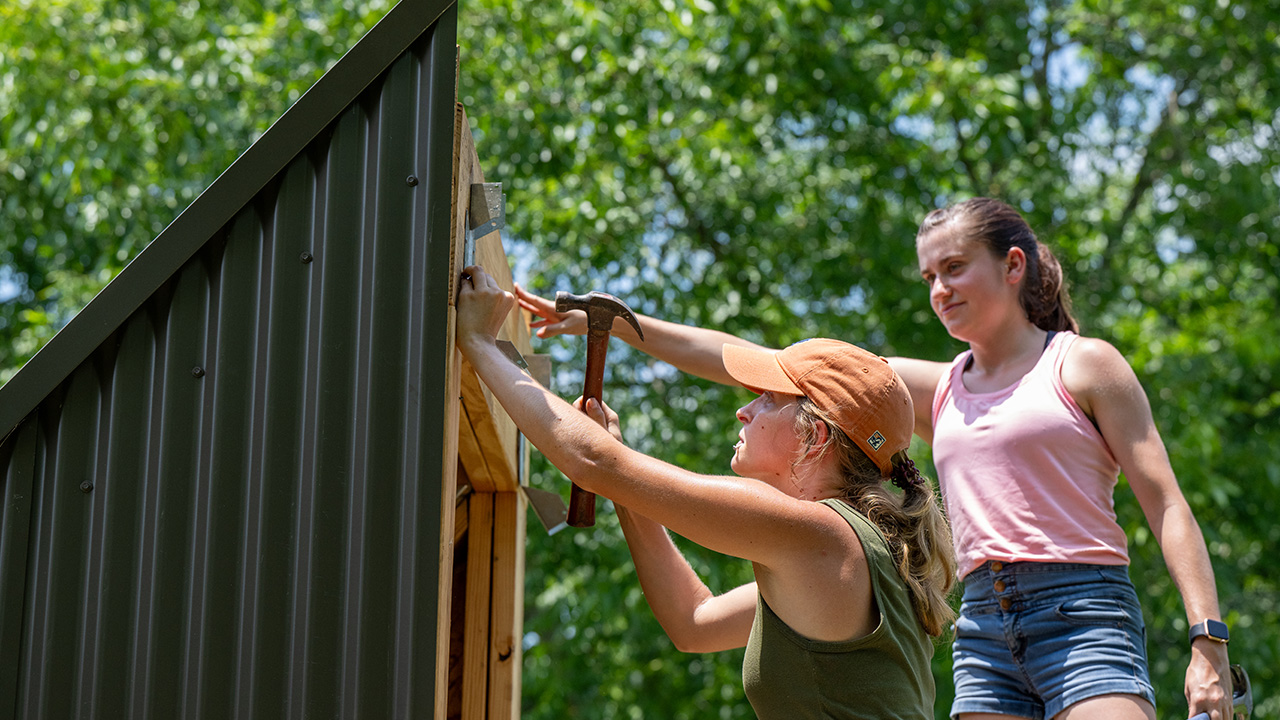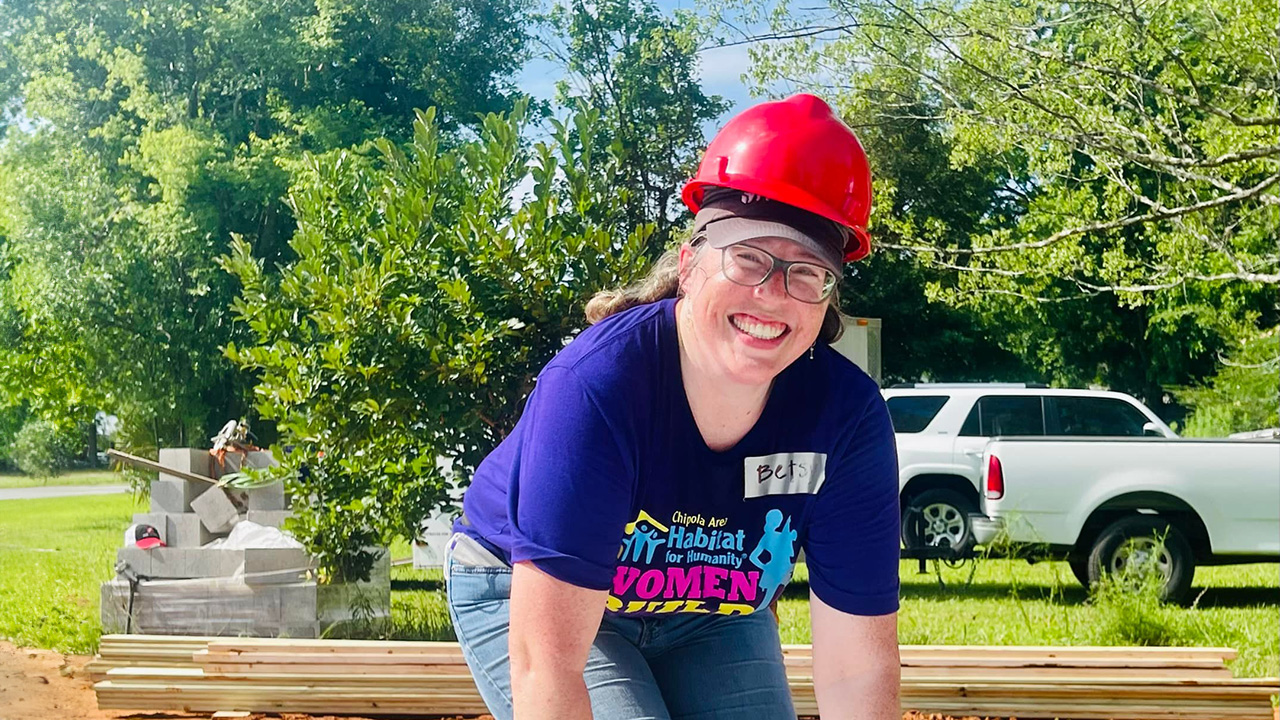content body
As part of their work for the Front Porch Initiative, four Auburn University faculty members help create housing designs that can mitigate rain, wind and flooding damage that result from a hurricane or tropical storm.
While their designs change for each partner and location, the organization’s goal of providing beautiful, affordable housing for all, in addition to focusing on efficiency, health and wellness and strengthening communities, does not.
“It’s essential that housing be durable, buildable, weatherproof and secure,” said Rusty Smith, associate director of Rural Studio. “We also believe a successful housing design should directly express a sense of presence and dignity for the homeowner. It should intentionally foster a sense of community engagement in its design.”
A research and outreach program of the College of Architecture, Design and Construction, the Front Porch Initiative currently partners with 26 community organizations in nine states, many of them Habitat for Humanity affiliates, which implement those designs. The innovative housing prototypes are initially generated by Rural Studio student teams.
When a partner approaches them, Smith and his team — which includes faculty members Mackenzie Stagg, Betsy Farrell Garcia and Christian Ayala Lopez — modify the designs to fit each client’s needs, extending the impact of Rural Studio’s applied housing research far beyond west Alabama. Partners are always welcome to make changes to the housing plans to better suit their needs.
“We take those products developed at Rural Studio and modify them to fit the building codes of that locality and to allow for any beyond code standards the partner wants to incorporate,” Garcia said. “Then, we provide them technical assistance to build to the standards they choose. That usually involves us building a computational model for energy, which is an estimate of how much power the house will consume.”
When a partner approaches them, Smith and his team — which includes faculty members Mackenzie Stagg, Betsy Farrell Garcia and Christian Ayala Lopez — modify the designs to fit each client’s needs, extending the impact of Rural Studio’s applied housing research far beyond west Alabama. Partners are always welcome to make changes to the housing plans to better suit their needs.
“We take those products developed at Rural Studio and modify them to fit the building codes of that locality and to allow for any beyond code standards the partner wants to incorporate,” Garcia said. “Then, we provide them technical assistance to build to the standards they choose. That usually involves us building a computational model for energy, which is an estimate of how much power the house will consume.”
In some cases, the Front Porch team collects data from homes once they’re built. The faculty members study energy consumption, indoor air quality, ambient light, temperature and relative humidity to learn how a home performs compared to its predicted performance.
“As we continue to build houses, we’ll have both a quantitative and qualitative analysis of the homes against what we designed in a computer,” Smith said.
Taking resiliency to the Gulf Coast
Since the Front Porch Initiative’s partners are spread across the Southeast, the standards they use to build can vary widely. However, in recent years, Garcia and her colleagues are seeing their partners on the Gulf Coast working toward building more resilient houses — structures that can withstand intense wind and rain, minimizing water or roof damage.
One of those partners is Chipola Area Habitat for Humanity in Marianna, Florida, about an hour-and-a-half inland from the coast. This community is still recovering from the direct hit it took from Hurricane Michael in 2018, and aerial views still show blue tarps on damaged roofs dotting the landscape. Garcia said increasing resilience of older homes can be expensive and complex, but new homes can include features and detailing implemented during construction that minimize damage from the gusty wind and rain of hurricanes.
“Chipola Habitat currently builds to beyond code standards,” Garcia said. “They’re building to Energy Star and to a resilience standard called FORTIFIED to meet funding requirements, as well as to reduce homeowners’ utility bills and insurance premiums. That affiliate partner has been fantastic because of their foresight in thinking of their homeowners, considering not just the first cost of the home, but also the operational cost of the home.”
Smith agrees with that view.
“Sometimes, getting folks in a house that costs more to build is actually what’s most affordable,” he said.
Making homes more resilient
The Insurance Institute for Business and Home Safety (IBHS) has found most insurance claims after a hurricane are made due to water infiltration. The organization has developed the FORTIFIED standard to guide builders and developers in hurricane-prone areas in making relatively simple changes during construction to protect homes from water.
Some of those changes include impact-resistant windows and doors, nailing down roof sheathing at smaller intervals and a sealed roof deck, which means there’s a weather barrier underneath the primary roofing, whether that’s two layers of roofing paper or a simple peel-and-stick underlayment.
Garcia knows that extra layer makes a big difference in reducing the repairs homeowners need to make after a storm and the time they might have to stay in a hotel during repairs.
“If a limb falls on the house, it may knock the shingles off, but you still have that secondary barrier to keep the water out,” she said. “Reducing the amount of water damage and reducing the displacement of those residents can avoid a significant number of insurance claims.”
Building in hurricane-prone Florida
After Hurricane Andrew hit in 1992, the state of Florida developed strict building codes for all new structures requiring impact-resistant windows and a sealed roof deck. Since wind speeds vary by geography, construction materials do, too. Homes built with reinforced wood construction, like those in Chipola, may be sufficient in inland northern Florida, while concrete block construction is required closer to the coast.
“Code requires tie-downs to the foundation every four feet,” Garcia said. “These homes have rods that go through the wall and tie down the top, and then they tie down the roof to that, and it secures everything rigidly from roof to foundation.”
Building in the bayou
Another Front Porch Initiative partner is New Orleans Area Habitat for Humanity. The organization is currently working to provide housing for residents an hour south of New Orleans, in Jean Lafitte, Louisiana, where rising tides mean more frequent water damage. While Florida’s building codes are quite strict, Louisiana has adopted the International Residential Code, which is less tailored to local conditions. To protect their homeowners from storm damage, Habitat for Humanity is building well beyond code.
So, why rebuild in an area vulnerable to hurricane damage? With a population of around 1,700 residents, Jean Lafitte produces 30% of Louisiana’s seafood, and many of its residents work in the fishing industry. Some families in Jean Lafitte live on land that’s been passed down through generations.
The first Habitat home here was built to the FORTIFIED Gold standard, and another is currently under construction. Both have impact-resistant windows and are elevated 12 feet above sea level, well above the flood levels seen during Hurricane Ida.
“IBHS estimates that investing in hazard mitigation has been proven to save recovery costs at a rate of six to one: investing $1 in mitigation saves $6 in recovery,” Garcia said. “Building a home stronger at the outset is a small investment relative to the cost of recovery after a disaster. It just makes sense to build things more resiliently.”










